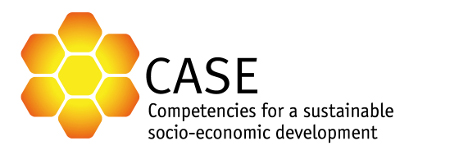 What is it about?
What is it about?
The Sustainability Competencies Tool is a tool to make individual competencies for sustainable development visible and to give support to further development.
It assumes a holistic understanding of competence that includes values, knowledge and the ability to implement. The aim of the tool is to initiate reflection and dialogue processes on one`s own competencies and to motivate to develop the potentials further.
It can be used as support for self-evaluation as well as for feedback processes in peer-groups, with coaches or teachers. Above all, the tool is used by students in the context of sustainability-oriented teaching events, but can also be transferred to sustainability-oriented companies and non-profit organizations in a modified form.
The five fields of sustainability competencies serve as a guiding frame and are divided into five sub-competencies. Students should reflect upon each sub-competence and figure out, what it means in the context of the course.
For each sub-competence impulse questions are available which help to reflect upon the own competence development.
The tool proposes three components of competencies:
- importance,
- knowledge and
- application
Students should evaluate each component on a scale from 0-3, bearing in mind that the self-assessment reflects their individual perception. The assessment-process can be guided through questions like:
- How important is the sub-competence from my perspective? Is it in line with my prioritized values?
- How do I assess my understanding and knowledge in the indicated field?
- Do I apply the knowledge in practice? Which practical experiences have I gained?
As a result of the evaluation, a numeric value is shown for each sub-competence and for the competence field in total, that allows several conclusions. Therefore step 3 is crucial, where students give a qualitative interpretation/justification of the results and deduce options for their own qualification path. The quantitative results can also be verified in dialogues with peers or teachers and thus deepen the reflection-process.
In this context, deviations within the three components of competencies are of particular interest. For instance, if importance is high-rated, knowledge and practical experience however low-rated, it could have implications on personal development but on development of curricula as well.
Depending on the course’s objective and relevance of reflection- and feedback processes, the results of the self-assessment can be compared with different values:
- Maximum: Every sub-competence has a maximum to reach, what means the expert status.
- Results of previous assessments: the comparison with earlier assessments (for example, at the beginning of a course) shows the individual development of competencies.
- Results of external evaluations: the comparison with the result of peer or teacher assessments supports the verification of the self-perception.
If comparative values are used, it is of particular importance to ensure that they are well embedded in a constructive dialogue and feedback setting.
The values, generated out of the assessment are graphically displayed in a line chart, which provides a quick overview of strengths, weaknesses and development potentials. If comparison values are used, they are displayed in a corresponding line chart.
The three components of competencies are indicated through three different colors, as the graphic below shows.
 Features
Features
- Self-evaluation
- External evaluation
- Pre-post comparison
- Graphical visualization
 Where to use it?
Where to use it?
 Downloads
Downloads
- Manual Competencies Tool – EN (pdf) including a detailed description and background information
- Manual Competencies Tool – CS (pdf)
- Manual Competencies Tool – DE (pdf)
- Manual Competencies Tool – IT (pdf)
- Manual Competencies Tool – SV (pdf)

